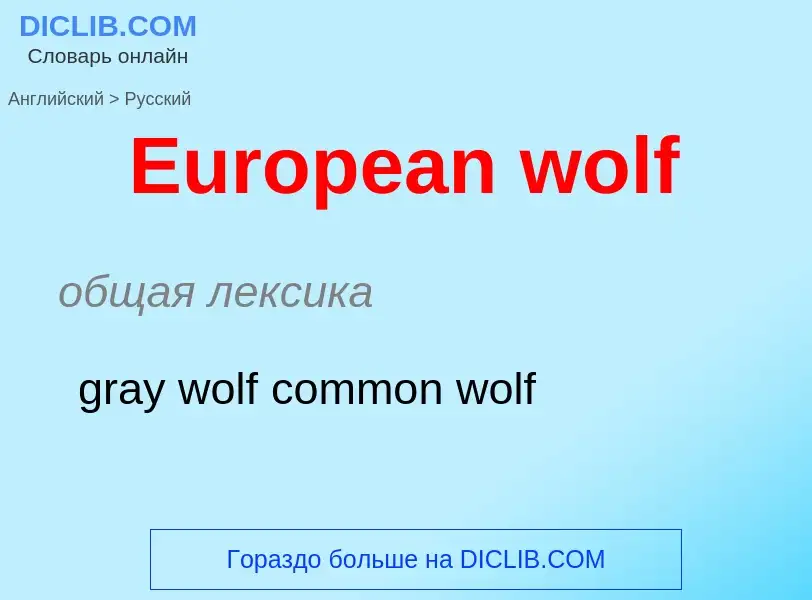Vertaling en analyse van woorden door kunstmatige intelligentie
Op deze pagina kunt u een gedetailleerde analyse krijgen van een woord of zin, geproduceerd met behulp van de beste kunstmatige intelligentietechnologie tot nu toe:
- hoe het woord wordt gebruikt
- gebruiksfrequentie
- het wordt vaker gebruikt in mondelinge of schriftelijke toespraken
- opties voor woordvertaling
- Gebruiksvoorbeelden (meerdere zinnen met vertaling)
- etymologie
European wolf - vertaling naar Engels
общая лексика
gray wolf common wolf
общая лексика
(обыкновенный) волк (Canis lupus)
[wulf]
общая лексика
"Вулф" (фирменное название различных видов ручного рабочего инструмента для бытового и промышленного применения; производится компанией "Вулф тулз" [Wolf Tools])
Definitie
Wikipedia

The Eurasian wolf (Canis lupus lupus), also known as the common wolf, is a subspecies of grey wolf native to Europe and Asia. It was once widespread throughout Eurasia prior to the Middle Ages. Aside from an extensive paleontological record, Indo-European languages typically have several words for "wolf", thus attesting to the animal's abundance and cultural significance. It was held in high regard in Baltic, Celtic, Slavic, Turkic, ancient Greek, Roman, and Thracian cultures, whilst having an ambivalent reputation in early Germanic cultures.
It is the largest of Old World grey wolves, averaging 39 kg (86 lb) in Europe; however, exceptionally large individuals have weighed 69–79 kg (152–174 lb), though this varies according to region. Its fur is relatively short and coarse, and is generally of a tawny colour, with white on the throat that barely extends to the cheeks. Melanists, albinos, and erythrists are rare, and mostly the result of wolf-dog hybridisation. The howl of the Eurasian wolf is much more protracted and melodious than that of North American grey wolf subspecies, whose howls are louder and have a stronger emphasis on the first syllable. The two are, however, mutually intelligible, as North American wolves have been recorded to respond to European-style howls made by biologists.
Many Eurasian wolf populations are forced to subsist largely on livestock and garbage in areas with dense human activity, though wild ungulates such as moose, red deer, roe deer and wild boar are still the most important food sources in Russia and the more mountainous regions of Eastern Europe. Other prey species include reindeer, argali, mouflon, wisent, saiga, ibex, chamois, wild goats, fallow deer, and musk deer.



![Comparison [[German shepherd dog]] Comparison [[German shepherd dog]]](https://commons.wikimedia.org/wiki/Special:FilePath/Canis-lupus-familiaris-german-shepherd4.jpg?width=200)


![[[Bavarian Forest National Park]], Germany [[Bavarian Forest National Park]], Germany](https://commons.wikimedia.org/wiki/Special:FilePath/Grey wolves in Bavarian Forest National Park (cropped).jpg?width=200)
![The last wolf in central Finland was killed in 1911 in the town of [[Karstula]]. The last wolf in central Finland was killed in 1911 in the town of [[Karstula]].](https://commons.wikimedia.org/wiki/Special:FilePath/Last wolf in Central Finland.jpg?width=200)
![Map showing the number of wolf attacks in France by ''[[département]]'' from 1400 to 1918 Map showing the number of wolf attacks in France by ''[[département]]'' from 1400 to 1918](https://commons.wikimedia.org/wiki/Special:FilePath/Map of wolf attacks on humans in France with text.png?width=200)
![[[Polychrome]] [[cave painting]] of a grey wolf, [[Font-de-Gaume]], France [[Polychrome]] [[cave painting]] of a grey wolf, [[Font-de-Gaume]], France](https://commons.wikimedia.org/wiki/Special:FilePath/Men of the old stone age (1915) Wolf.png?width=200)



![Wolf attacks at night and by day <ref>Michel Meuret, Laurent Garde, Charles-Henri Moulin, Marie-OdileNozières-Petit, Marc Vincent: ''[https://hal.archives-ouvertes.fr/hal-01739303/document Élevage et loups en France : historique, bilan et pistes desolution]''</ref> Wolf attacks at night and by day <ref>Michel Meuret, Laurent Garde, Charles-Henri Moulin, Marie-OdileNozières-Petit, Marc Vincent: ''[https://hal.archives-ouvertes.fr/hal-01739303/document Élevage et loups en France : historique, bilan et pistes desolution]''</ref>](https://commons.wikimedia.org/wiki/Special:FilePath/Wolf attacks at night and by day.png?width=200)


![Polar Park]] in [[Bardu]], [[Troms]], Norway Polar Park]] in [[Bardu]], [[Troms]], Norway](https://commons.wikimedia.org/wiki/Special:FilePath/Wolves in Norway.jpg?width=200)
